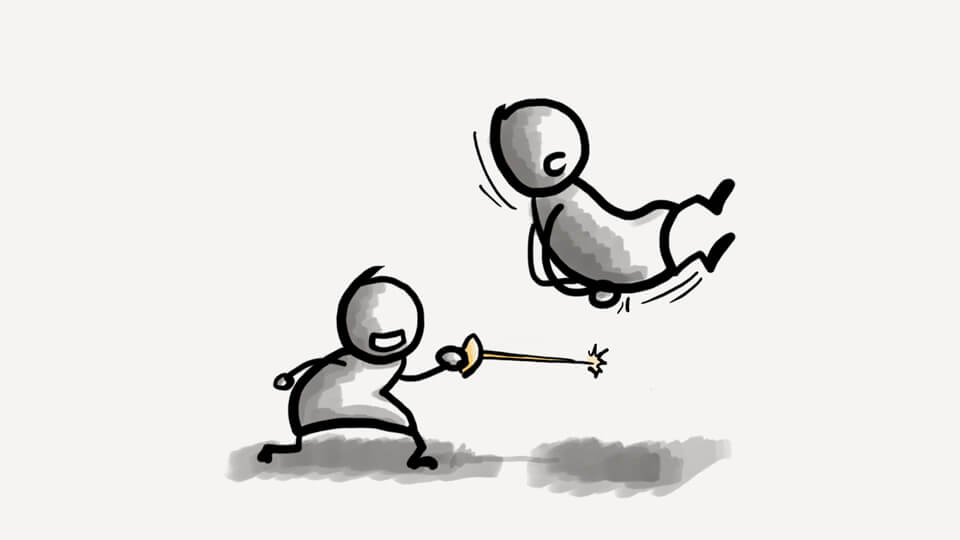Everyone who writes wants to write well. And yet bad prose gets written all the time. Errors creep into our writing during the artistic fervor of getting ideas out on the page. Making sure these ideas read well come much later in the process.
Today I’ll share one of the most valuable techniques I learned in my years of writing. Use it and you’ll immediately observe a leap in the quality of your narrative.
What are Motivation Reaction Units?
In an 80s book about writing called Techniques of the Selling Writer, the author Dwight V. Swain cracked the remarkably simple code of compelling prose. To be clear, we’re not talking about story arcs, conflicts, and resolutions. There’s a whole mountain of material on that. We’re talking about compelling sentences, and paragraphs that come together to form a flowing narrative.
Compare the two following examples.
Example 1
“You can’t run forever…” Jessie said in a desperate attempt after Frankie slipped his hand from her grip and walked away not turning back even once. She had tried to grab him. No, this can’t be. Maybe one last embrace could’ve stopped him.
The words he said, rung loud in her head and sent a cold shiver down her spine: “This isn’t a life for you. You’ll be better off without me.”
(yuck!)
Example 2
“This isn’t a life for you. You’ll be better off without me,” Frankie said.
No, this can’t be. Frankie’s words sent a cold shiver down Jessie’s spine. What if one last embrace could stop him? She tried to make a grab for him, but his hand slipped from her grip.
“You can’t run forever,” she said in a desperate attempt.
Frankie walked away. He didn’t turn back.
The Difference
Writing the first example hurt my eyes, and made at least a couple of keycaps pop out of my keyboard in protest. But if you think about it basically says the same thing as Example 2 (I even made sure to use similar wording). Why then is example 1 so painful to read?
Even though it tells the same story, it messes up the order of Motivation-Reaction Units (MRUs).
Have you ever saw a ball fly into the air before anyone kicked it? God, I hope not. Same goes for stories. Motivations come first, reactions second.
Get the order even slightly wrong, and you risk taking the reader out of your fantasy.
What are Motivations?
Theory time. I’ll make it short and sweet. Motivations are things that happen to the protagonist and make him act. External stimuli in most cases.
Smell. Like the stench of a burning tavern.
Sight. Finding a dead body on the floor.
Touch. Being punched in the face.
Sound. Someone screaming for help.
Taste. Sensing poison in the wine.
Thoughts Remembering you forgot dad’s birthday yesterday.
Any of the above should suffice to spur our hero into action.
What are Reactions?
Here things get a little tricky because while there’s usually only a single motivation, it leads to multiple reactions. And for the prose to read well, the reactions need to happen in the most natural order:
1. Involuntary thoughts and emotions. Internal monologue or feelings.
2. Involuntary physical responses A chill down the spine, eyes going wide, legs trembling, and such.
3. Conscious action Looking around, straightening up, putting hands in your pocket to wipe off sweat.
4. Speech and dialogue come last.
Getting it right
I encourage you to go and revisit examples 1 and 2 now. Can you recognize each motivation-reaction unit there? I’ve written example 1 in a completely the wrong order. Words come before emotions, and reactions before we know what happened to cause them in the first place. Example 1 is horrible to read, isn’t it?
Example 2, on the other hand, demonstrates how to get motivation reaction units right. First comes the motivation, then feelings, an involuntary physical response, conscious thought, action, and finally speech.
As homework, I highly recommend you pick up one of your recent stories. Find where you tripped up, and fix these passages using the right motivation-reaction order.
If you can get into a regular habit of checking MRUs, you’ll soon become a better writer than most.
Further reading
If you want to learn more about the topic these two articles should come in handy:


[…] I ever came to possessing what felt like a closely guarded secret was when I found out about Motivation-Reaction Units in prose. Other than that, though? Everything I learned about writing was just reading someone […]
[…] Here, the character reacts to something that hasn’t happened yet, i.e. a stimulus the reader hasn’t been told about yet. This kind of writing confuses the reader. We want to structure the narrative flow according to the Motivation-Reaction Units. […]
Whaaaat?! I never thought of that while writing. I will be way more aware of getting my MRUs right from now on. Thank you for the tip.